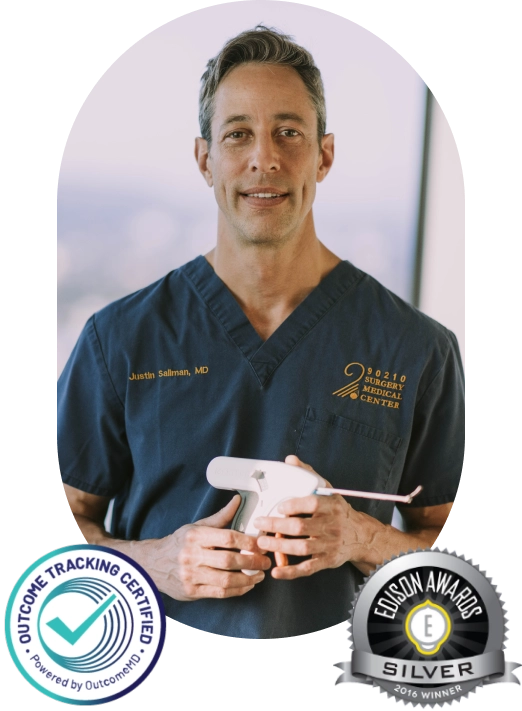HAVE YOUR ACL TEAR RECONSTRUCTED WHILE
SAVING YOUR MENISCUS
Discover the latest technology and what most Doctors aren’t telling you about your ACL injury.
The problem with ACL tears
Anterior Cruciate Ligament (ACL) tears are a common and significant injury, primarily affecting those involved in activities that require quick changes in direction or pivoting movements.
As one of the major ligaments in the knee, the ACL’s primary role is to stabilize the joint by preventing excessive forward movement of the tibia (shinbone) relative to the femur (thighbone). When the ACL is torn, it can lead to a range of issues and complications, including:
Instability
The torn ACL can result in knee instability, making it challenging for the affected individual to bear weight, change direction, or perform physical activities normally.
Muscle Weakness
After an ACL tear, the muscles around the knee may weaken due to decreased use and immobility. This muscle weakness can contribute to further knee instability and functional limitations.
Meniscus Damage
It is very common to tear your meniscus when you tear
your ACL. At the time of ACL reconstruction, many
surgeons will leave the tear there or remove major
functional regions of your meniscus. If you live with a ACL tear you are at risk of your knee buckling, and the buckling can tear your meniscus.
ACL tear treatment options
The treatment for an ACL tear depends on several factors, including the severity of the tear, the individual’s activity level, and their overall health. There are two primary treatment options for an ACL tear: non-surgical management and surgical reconstruction.

Non-Surgical Management
For partial ACL tear or individuals with a relatively low activity level, non-surgical treatment may be recommended. This approach typically involves a combination of rest, physical therapy, and activity modification. Non-surgical management may be suitable for older individual or those with minimal instability and who are not engaged in high-demand sports or activities.
Rest, Physical Therapy, Knee Bracing, Avoiding high-impact and high-risk activities.
Surgical Reconstruction
For athletes, active individuals, those with severe ACL tears, or those who are experiencing instability with activities of daily living, surgical reconstruction is often recommended to restore knee stability and function fully. Surgery involves replacing the torn ACL with a graft (usually taken from the patient’s hamstring tendon, patellar tendon, quadriceps tendon, or a cadaver graft) to create a new ligament. During the surgery, the damaged ligament is removed, and the graft is paced in the anatomical position of the original ACL, securing it with screws or other fixation devices.

The decision between non-surgical and surgical treatment is complex and should be made in consultation with an orthopedic surgeon.
Approximately 70% of ACL tears are associated
with a meniscus tear.
Studies have shown that a significant percentage of individuals who experience an ACL tear also have a concurrent meniscus tear.
The combination of an ACL tear and a meniscus tear can complicate the treatment and recovery process. The presence of a meniscus tear can impact the surgical approach, affect rehabilitation protocols, and may influence the overall prognosis for the patient.
Whenever speaking to a doctor about an ACL tear, it’s crucial that they do not overlook a potential accompanying meniscus tear.
Reconstructing the ACL without properly addressing a concurrent meniscus tear can lead to serious complications.
The meniscus and the anterior cruciate ligament (ACL) are critical components of the knee joint. The meniscus spreads out the forces in the knee to protect the cartilage surfaces, while the ACL provides rotational stability. An injury to either of these components can significantly affect knee function and lead to long-term complications, such as:

- Osteoarthritis.
- Knee Pain.
- Limited Range of Motion.
- Re-tears.
All of this increases the risk of needing a knee replacement surgery in the future.
Unfortunately, because of a lack of skills and knowledge, many doctors opt to ignore the meniscus tear or suggest a treatment option that addresses the symptoms in the short-term (meniscus ‘clean up’ or ‘trimming’) while causing osteoarthritis in the long-term.

Dr. Justin Saliman is a Stanford orthopedic surgeon who invented the Edison Award-winning “Novo Stitch Pro Meniscal Repair System” and the “Circumferential Stitching” technique. After over 20 years of experience, he has serviced hundreds of ACL and meniscus tear patients with the most modern techniques. No one in the world has more experience repairing meniscus tears of all patterns.
For ACL Reconstructions, Dr. Saliman uses the GraftLink technique, a cutting-edge and precise method for ACL reconstruction. With the help of advanced tool like the FlipCutter® III drill and anatomic guides, it enables the creation of sockets in the femur and tibia, ensuring anatomic alignment and maximum fixation. The use of TightRope® II implants with a unique 5-point locking system further enhances the reproducibility of this technique.
For Meniscus Repairs, Dr. Saliman’s NovoStitch medical device allows him to place circumferential sutures around meniscus tears – providing uniform, anatomic compression of the tear edges. This unique treatment allows him to arthroscopically sew all meniscus tear types, including those previously considered difficult or impossible to sew back together.
Why the GraftLink Technique is the best
treatment for ACL reconstruction
Anatomic
Independent socket preparation allows for precise placement of the ACL graft, promoting better functionality and long-term stability.
Minimally Invasive
The FlipCutter® III reamer minimizes tissue damage, preserving bone and periosteum while ensuring successful socket preparation.
Reproductible
The GraftPro® graft preparation system simplifies the process, allowing for easy graft passing, fine-turning of graft depth, and adjusting graft tension from both the femoral and tibial sides.
Less is More
Most techniques require large screws to be place to smoosh the graft against the wall of the tunnel to hold the graft in place. With the FlipCutter technique, the diameter of the tunnel exactly matches the diameter of the graft, and no large screws interfere. The graft hence has circumferential healing to bone around is entire circumference.
Send a message to Justin D. Saliman, MD
If you have any questions, concerns, or comments regarding Dr. Justin Saliman or your knee
condition, please fill out the short contact form below
 +1(310)7035819
+1(310)7035819




